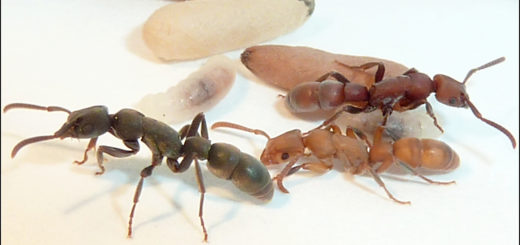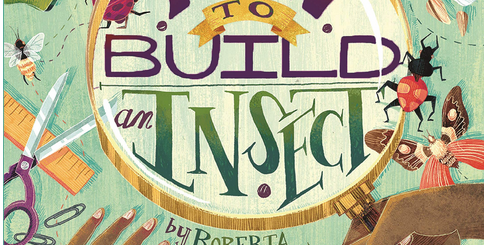Women’s History: Adele Marion Fielde

Pagoda shadows: studies from life in China, London: T. Ogilvie Smith, p. frontispiece.
In some countries, March is Women’s History Month and a good time to remember the work of women who studied ants in centuries past.
One such ant researcher was Adele Marion Fielde (March 30, 1839 – February 23, 1916), who published over 20 papers about ants in scientific journals between the years 1900 and 1907.
A View by Roberta Gibson

Research Highlights
Adele Fielde is probably best known for the portable ant observation nest known as the Fielde Nest, which she described in a 1900 paper in The Biological Bulletin. William Morton Wheeler included instructions for making one in his 1910 book, Ants: Their Structure, Development and Behavior, Appendix A, pp. 550-554. The nests were constructed of panes of glass for ease of viewing, yet were compact so several nests could be stored in a portable case made of wood.
After devising the nest, she used it for her observational studies. In 1903 she snipped off various lengths of the antennae of ants and discovered which segments where used in nest mate recognition. Normally ants of different species will fight when placed together, but she was able to create a nest with Stigmatomma pallipes, Camponotus pennsylvanicus, Formica sanguinea, Stenamma fulvum and Cremastogaster lineolata living in harmony by removing sections for their antennae.
Her paper in 1904 with G. H. Parker on “The reactions of ants to material vibrations,” which was published in Proceedings Acad. Natural Sciences of Philadelphia, showed that ants don’t react to sound moving through the air, but instead perceive vibrations in the substrate they stand on. The paper is still cited today.
Biography
Adele Fielde, however, was much more than a scientist. She also worked as a missionary in China, wrote a Chinese – English Dictionary (Swatow Dialect) and campaigned for women’s suffrage. How did she come to study ants and why did she abruptly stop in 1907?
Early Years
Trained as a teacher at Albany Normal College, Miss Fielde began her career teaching school in Long Island, New York, U.S. in 1860. A few years later, she accepted a marriage proposal from a missionary named Cyrus Chilcott who was on his way to China. Fielde followed Chilcott a year later, but when she reached China she learned that her fiancé had died. Rather than returning to the United States, she stayed abroad and, although she returned to the United States a few times, remained in China for extended periods between the years 1866 and 1889 when she left for the last time.
Scientific Training
From 1883 to 1885, during one of her breaks from China, Adele Fielde decided to study medicine at the Medical College of Pennsylvania in order to help improve women’s health. Although females were allowed to take classes at the college, the male students regularly harassed them. After one incident, Miss Fielde explained in some detail how Chinese women in the areas she had lived suffered during birth because they were not allowed to see a male doctor. According to reports, the men behaved better after that.
At the same time, Fielde also developed an interest in evolution. To understand more about biology, she started studying at the Philadelphia Academy of Natural Sciences and spent two years there. She did not, however, ever receive a formal degree.
Marine Biological Laboratory, Woods Hole
After she returned from China for the last time, Adele Fielde spent summers at the Marine Biological Laboratory in Woods Hole, Massachusetts from 1894 until 1907. She was both a student and a lecturer and that is where she did her research on ants.
Why go to Woods Hole? At the time the Marine Biological Laboratory was one of the few institutions that admitted and encouraged female students. It was also the summer home for a number of respected scientists who did research and taught students.
One of those scientists was the renowned myrmecologist, William Morton Wheeler. According to records, he summered at Woods Hole from 1889 -1892, 1894, and for several more years starting in 1889. It is likely that Adele Fielde learned how to identify ants from him as well as discuss other aspects of myrmecology. As mentioned above, he was aware of her work that he referenced in his own book. The two, however, never published a paper together.
Abruptly, in the summer of 1907, Adele Fielde left the East Coast and moved to Seattle, Washington. One of her biographers, Helen Norton Stevens, suggests although Fielde gave an excuse it was for her health, she also had other reasons she never revealed. It may or may not be a coincidence, but the same year Charles Otis Whitman, the founding director at Woods Hole — who had been so open to enrolling female students — stepped down. In any case, Miss Fielde never published another paper about ants for the rest of her life.
Given all her accomplishments in such a short period, one has to wonder what else Adele Fielde might have discovered if she had received formal training and if she had devoted her life to the study of ants.

Adele M. Fielde’s Publications: Ant Research
_____.1900. Portable ant nests. – Biological Bulletin of the Marine Biological Laboratory, Wood Hole, 2: 81-85. https://www.journals.uchicago.edu/toc/bbl/1900/2/2
_____.1901a. A study of an ant. – Proceedings of the Academy of Natural Sciences of Philadelphia, 53: 425-449. https://www.jstor.org/stable/4062595
_____.1901b. Further study of an ant. – Proceedings of the Academy of Natural Sciences of Philadelphia 53: 521-544. https://www.jstor.org/stable/4062764
_____.1902. Notes on an ant. – Proceedings of the Academy of Natural Sciences of Philadelphia 54: 599-625. https://www.jstor.org/stable/4062709
_____.1903a. Further study of an ant. – Proceedings of the Academy of Natural Sciences of Philadelphia 53: 521-544. https://www.jstor.org/stable/i386503
_____. (1903b). Supplementary Notes on an Ant. – Proceedings of the Academy of Natural Sciences of Philadelphia, 55: 491-495. https://www.jstor.org/stable/4062909
_____.1903c. Experiments with ants induced to swim. – Proceedings of the Academy of Natural Sciences of Philadelphia, 55: 617-624. https://www.jstor.org/stable/4062917
_____. 1903d. Artificial mixed nests of ants. – Biological Bulletin of the Marine Biological Laboratory, Wood Hole, 5: 320-325. https://www.journals.uchicago.edu/toc/bbl/1903/5/6
_____. 1903e. A cause of feud between ants of the same species living in different communities. Biological Bulletin of the Marine Biological Laboratory, Wood Hole, 5: 326-329. https://www.journals.uchicago.edu/toc/bbl/1903/5/6
_____. 1904a. Observation on ants in their relation to temperature and to submergence. – Biological Bulletin of the Marine Biological Laboratory, Wood Hole, 7: 170-174. https://www.journals.uchicago.edu/toc/bbl/1904/7/3
_____. 1904b. Portable ant-nests. – Biological Bulletin of the Marine Biological Laboratory, Wood Hole, 7: 215-220. https://www.jstor.org/stable/1535796
_____. 1904c. Power of recognition among ants. – Biological Bulletin of the Marine Biological Laboratory, Wood Hole, 7: 227-250. https://www.journals.uchicago.edu/toc/bbl/1904/7/5
_____. 1904d. Tenacity of life in ants. – Biological Bulletin of the Marine Biological Laboratory, Wood Hole, 7: 300-309. https://www.journals.uchicago.edu/toc/bbl/1904/7/6
_____. 1904e. Three Odd Incidents in Ant-Life. – Proceedings of the Academy of Natural Sciences of Philadelphia 56: 639-41. https://www.jstor.org/stable/4062954
_____. 1905a. Observations on the progeny of virgin ants. – Biological Bulletin of the Marine Biological Laboratory, Wood Hole, 9: 355-360. https://www.journals.uchicago.edu/toc/bbl/1905/9/6
_____. 1905b. Temperature as a Factor in the Development of Ants. With Further Observations on Ants Deprived of Food. – Biological Bulletin, 9: 361-367. https://www.journals.uchicago.edu/toc/bbl/1905/9/6
_____. 1905c. The progressive odor of ants. – Biological Bulletin of the Marine Biological Laboratory, Wood Hole, 10: 1-16. https://www.journals.uchicago.edu/toc/bbl/1905/10/1
_____. 1905d. Tenacity of life in ants. – Scientific American, 93: 363-364. https://www.jstor.org/stable/24999873
_____. 1906. Longevity of a Velvet Ant. – Biological Bulletin, 11: 265-266. https://www.jstor.org/stable/1535748
_____. 1907. Suggested Explanations of Certain Phenomena in the Lives of Ants; With a Method of Tracing Ants to Their Respective Communities. – Biological Bulletin 13: 134-7. https://www.jstor.org/stable/1535599
Fielde, A.M., and G. H. Parker. 1904. The reactions of ants to material vibrations. – Proceedings Acad. Natural Sciences of Philadelphia, 56: 642–649. https://www.jstor.org/stable/4062955
Biographies:
Stevens, Helen Norton. 1918. Memorial Biography of Adele M. Fielde: Humanitarian. The Fielde Memorial Committee. https://archive.org/details/memorialbiograp00stevgoog/page/n7/mode/2up
Warren, Leonard. 2002. Adele Marion Fielde: Feminist, Social Activist, Scientist. Routledge: London.





Very interesting.
Maybe I am wrong but from who is the next reference:
Fielde, A. M. 1915. On certain vesicles found in the integument of ants. Proceedings of the Academy of Natural Sciences of Philadelphia 67:36-40.
Thank you. Marc.
Good find. According to her biographers Adele Fielde stopped writing papers, but continued correspondence with those interested in ants. Since she passed away in 1916, this is likely hers. I’ll add it to the list in the future. Thank you for sharing.
Thanks. You can find the reference, without pdf, at AntCat. It is the only one they have. Yours. Marc
If you are interested, I have found a copy of the 1915 article. I can send it to you, if I have your email adress. In it is also mentioned an article written by her in 1914… If there aren’t more of them. Yours. Marc.